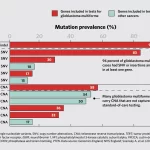Omicron Variant highly transmissible than Delta Variant of SARS-COV-2 -Computational study shows
December 29, 2021In South Africa, the Omicron variant of severe acute respiratory syndrome coronavirus 2 (SARS-CoV-2) has recently emerged. It has sparked a radical response in a number of countries worldwide, with countries reopening borders and reinstating some of the limitations that have been in place for the last two years. With a record number of mutations, the majority of which occur inside the spike protein’s receptor-binding domain (RBD), virtually little is known about the Omicron variation. Suresh Kumar researcher from Malaysia’s Management and Science University with Oxford researchers investigated the new variety using computational methods.
The Omicron Variant Study Compared with Delta Variant
The ProtParam online programm determined the molecular weight of each strain. This program determines the molecular weight, theoretical pI, amino acid composition, atomic composition, extinction coefficient, expected half-life, instability index, aliphatic index, and grand average of hydropathicity (GRAVY). A tool named GOR IV was used to predict the secondary structure. Intrinsic disorder regions (IDRs), locations in which PONDR predicted physiological settings with an ensemble of conformations, but I-Mutant predicted protein stability.
The researchers identified 30 mutations in the spike protein, approximately half of which are located inside the RBD. The T470-T478 loop and Y505 are required for detection of the RBD by angiotensin-converting enzyme 2 (ACE2). T478 is a variation that occurs in both Delta and Omicron. Although the wild-type variation contains 1273 amino acids, the Delta and Omicron variants include 1271 and 1270 amino acids, respectively.
The isoelectric point (pI) of a protein is defined as the pH value at which the surface is charged but the net charge is zero. Similar to pH, pI values more than 7 indicate an alkaline environment, whereas values less than 7 indicate an acidic environment. The wild-type versions have a molecular weight of 141178.47 and a pI of 6.24. The Delta variant has a molecular weight of 140986.31 and a pI value of 6.78, whereas the Omicron variant has a molecular weight of 141328.11 and a pI value of 7.14. The Omicron variant’s greater molecular weight is uncommon, as it contains fewer amino acids than both the wild-type and Delta versions.
In terms of stability scores, the researchers determined that the stability of all spike proteins was between 32.8 and 34.7, just above the 40 threshold that indicates a protein is structurally unstable. The aliphatic index is used to quantify thermostability, with higher values suggesting increased thermostability. The spike protein has a molecular weight of between 84.5 and 84.95, indicating good stability. The low GRAVY score indicates that it is hydrophilic on an inherent level.
Primary structural study show the increase in charged residues such as arginine, lysine, aspartic acid, and glutamic acid in the Omicron variant, implying that charged residues are exposed to greater degrees and salt bridges can form more easily. Additionally, Phenylalanine and Isoleucine appear more frequently in the Omicron variant than in the Delta variant, indicating that it is significantly more hydrophobic. Secondary structural examination of the Omicron variation revealed a greater fraction of alpha-helices than the Delta version, but fewer extended strand and random coil structures, resulting in increased structural stability.
In general, disordered regions of viral protein are associated with viral pathogenicity and infectivity, and the Omicron variant contains a less disordered region than the Delta strain or the wild type. The specific modifications show that a disorder to order transition occurred inside the spike protein, which may be required for ACE2 binding. All of the changes in the Delta variation are thought to diminish stability, and the Omicron variant appears to exhibit the same property. Only N501Y deviates from the trend. Additionally, N211I, Y50H, and N764K, as well as L452R and T478, present in the Delta strain, appear to impact protein function.
The spike RBD from ACE2 from solved crystal structure was used for protein-protein docking, indicating that the Omicron variation has the greatest score while the Delta variant has the lowest. This would imply that the ACE2 variation has a higher affinity for ACE2 and is more infectious than the Delta form. This is most likely the result of mutations in critical residues such as K31, which is damaged by the E484 mutation.
Conclusion
The authors highlight that their study provides valuable insight into the Omicron and Delta variants and the different mutations which drive them. The dynamic changes that can affect protein stability, ACE2 binding and infectivity were explored using computational tools and modeling. The researchers have provided a large amount of information that could be used to help researchers further investigate the new variant and predict how quickly it can spread and how much damage it could do.
Journal reference:
Preprint
Kumar, S. et al. (2021) “Omicron and Delta Variant of SARS-CoV-2: A Comparative Computational Study of Spike protein”. bioRxiv. doi: 10.1101/2021.12.02.470946 . https://www.biorxiv.org/content/10.1101/2021.12.02.470946v1
Publication
Kumar, S, Thambiraja, TS, Karuppanan, K, Subramaniam, G. Omicron and Delta variant of SARS-CoV-2: A comparative computational study of spike protein. J Med Virol. 2021; 1- 9. doi:10.1002/jmv.27526. https://onlinelibrary.wiley.com/doi/10.1002/jmv.27526




















